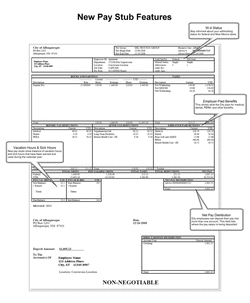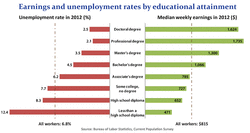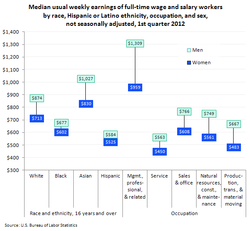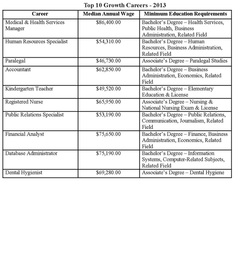
Chart 1. Pay Check Stub

Chart 2. Earnings & Unemployment Rates by Educational Attainment

Chart 3. Median Weekly Earnings

Chart 4. Top 10 Careers - 2013
I. Activating Prior Knowledge
Once you have gotten your job, you will receive a pay check. You may receive your pay weekly, bi-weekly or monthly. Analyzing your pay check and budgeting will become essential to your financial survival.
II. Setting A Purpose for Reading
Pretend that this is your first paycheck stub. What does this paycheck stub tell you about your job? How would you begin to budget your money?
III. Reading the Text
Using Chart 1 - Paycheck Stub, answer the following questions:
1. What is the name of the employer?
2. How much did you earn before taxes? What is this amount called?
3. What is your salary?
4. Are you paid weekly, bi-weekly, or monthly? What is the pay-period for this check?
5. What is being deducted from the paycheck?
6. How much federal income tax has been taken out of your check so far this year? How can you tell?
7. How much is your take home pay? What is this amount called?
8. How much money was deducted from your paycheck?
9. How much money have you earned so far this year?
10. What is meant by “before-tax deductions” and “after-tax deductions?”
IV. Personal Reflection
Here is a list of expenses for the month that you are required to pay (figures are based on the national average):
· Housing – You live in a one-bed apartment on the outskirts of the city. It costs $700.00 month. (This includes your water and trash, but does not include electricity.)
· Electricity – Your electricity usage ranges from $75.00 to $125.00.
· Food – Your monthly cost for food is $400.00 a month.
· Cell Phone – Your monthly cell phone bill is $71.00 a month.
· Saving – You should be saving 5 – 10% of your net pay.
· Automobile – This includes your car payment, insurance, maintenance, and gasoline is $745.00 per month.
1. Based on this information in Chart 1, how much money would you have for discretionary expenses at the end of the month?
2. How could you improve your financial situation?
Based on the information in Chart 2, answer the following questions:
3. What does this chart tell you about earnings and unemployment as it relates to educational attainment?
4. What career are you considering? How much education does it require? Given the median weekly earnings by educational attainment, how much could you expect to make in a month?
Based on the information in the Chart 3, answer the following questions:
5. Which ethnic group earns the most money? Give at least 2 reasons why this is the case?
6. Glass ceiling is defined as “an unofficially acknowledged barrier to advancement in a profession, especially affecting women and members of minorities.” Give 2 pieces of evidence that support this definition.
7. Based on the information in Chart 4, what conclusions can you draw about possible future careers?
8. Of the jobs listed in Chart 4, which would you be most interested in exploring and explain why you are interested in that particular career?
9. One of the most dreaded questions is “what do you want to be when you grow up?” As you prepare to answer this question, the following careers are to be considered off-limits: professional athlete, actor/actress, singer, or musician. Consider, while you may be the best football player to ever catch, throw, or run with a football, you should have a back-up plan in case you become injured and are unable to pursue that goal. To that end, “What do you want to be when you grow up and explain why you are interested in pursuing this career?”
Once you have gotten your job, you will receive a pay check. You may receive your pay weekly, bi-weekly or monthly. Analyzing your pay check and budgeting will become essential to your financial survival.
II. Setting A Purpose for Reading
Pretend that this is your first paycheck stub. What does this paycheck stub tell you about your job? How would you begin to budget your money?
III. Reading the Text
Using Chart 1 - Paycheck Stub, answer the following questions:
1. What is the name of the employer?
2. How much did you earn before taxes? What is this amount called?
3. What is your salary?
4. Are you paid weekly, bi-weekly, or monthly? What is the pay-period for this check?
5. What is being deducted from the paycheck?
6. How much federal income tax has been taken out of your check so far this year? How can you tell?
7. How much is your take home pay? What is this amount called?
8. How much money was deducted from your paycheck?
9. How much money have you earned so far this year?
10. What is meant by “before-tax deductions” and “after-tax deductions?”
IV. Personal Reflection
Here is a list of expenses for the month that you are required to pay (figures are based on the national average):
· Housing – You live in a one-bed apartment on the outskirts of the city. It costs $700.00 month. (This includes your water and trash, but does not include electricity.)
· Electricity – Your electricity usage ranges from $75.00 to $125.00.
· Food – Your monthly cost for food is $400.00 a month.
· Cell Phone – Your monthly cell phone bill is $71.00 a month.
· Saving – You should be saving 5 – 10% of your net pay.
· Automobile – This includes your car payment, insurance, maintenance, and gasoline is $745.00 per month.
1. Based on this information in Chart 1, how much money would you have for discretionary expenses at the end of the month?
2. How could you improve your financial situation?
Based on the information in Chart 2, answer the following questions:
3. What does this chart tell you about earnings and unemployment as it relates to educational attainment?
4. What career are you considering? How much education does it require? Given the median weekly earnings by educational attainment, how much could you expect to make in a month?
Based on the information in the Chart 3, answer the following questions:
5. Which ethnic group earns the most money? Give at least 2 reasons why this is the case?
6. Glass ceiling is defined as “an unofficially acknowledged barrier to advancement in a profession, especially affecting women and members of minorities.” Give 2 pieces of evidence that support this definition.
7. Based on the information in Chart 4, what conclusions can you draw about possible future careers?
8. Of the jobs listed in Chart 4, which would you be most interested in exploring and explain why you are interested in that particular career?
9. One of the most dreaded questions is “what do you want to be when you grow up?” As you prepare to answer this question, the following careers are to be considered off-limits: professional athlete, actor/actress, singer, or musician. Consider, while you may be the best football player to ever catch, throw, or run with a football, you should have a back-up plan in case you become injured and are unable to pursue that goal. To that end, “What do you want to be when you grow up and explain why you are interested in pursuing this career?”
 RSS Feed
RSS Feed